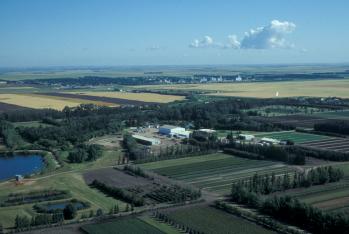
When the early settlers arrived in the North-West Territories, they found a treeless region with an extreme climate that would not support many of the plants that they had brought with them. In 1901, under the Department of the Interior the government of Canada established at Indian Head, in what is now Saskatchewan, the Forest Nursery Station, dedicated to researching, cultivating, and supplying hardy trees and shrubs to prairie farmers. Advice was provided as to where to plant the trees and how to care for them. The group plantings, known as shelterbelts, were planned to protect the settlers, their land and their livestock from the strong winds, as well as to provide relief during the cold winters and shade during the hot summers. Initially, broadleaf species such as American elm, caragana, green ash, Manitoba maple, poplar and willow were grown, as were evergreen varieties of larch, pine and spruce. The Colorado spruce, recognizable in most prairie farm shelterbelts, was not introduced until 1937. Seed from trees found in cold countries was collected and grown to assess survival under prairie conditions.
Orders for trees and shrubs grew at a rapid rate, and a second nursery was established in 1913 at Sutherland, near Saskatoon. Over the years, both stations tested and distributed many tree and shrub species; these plantings have done much to reduce soil erosion, trap snow for additional moisture, help increase farm water supply, and provide shelter for wild life. Both centres have also tested a range of fruit trees. Public information activities, such as fair displays, newspaper advertisements, pamphlets, and presentations to farm groups increased the profile of the nursery. In 1920, the CPR donated to the Forestry Associations of Western Canada a railway coach which traveled to stations with displays promoting the benefits of tree planting, forestry, and shelterbelts.
During the severe droughts of the 1930s the nurseries, in conjunction with the newly formed PFRA (Prairie Farm Rehabilitation Administration), worked to plant over 2,000 km of shelterbelts and demonstrated their use for soil conservation across the prairies. In 1963, the shelterbelt program became part of the PFRA. Two years later, with improvements to the Indian Head facility that included a new water reservoir as well as irrigation and cold storage facilities for trees and shrubs, the Sutherland nursery was shut down.
The Indian Head nursery has grown from its original quarter-section (64 ha) to a full section (256 ha). Between 1901 and 2001, more than 570 million evergreen and deciduous tree and shrub seedlings were distributed by the Indian Head Nursery as a service to prairie farmers as well as to federal, provincial, municipal and other agencies.
Today the Nursery produces twenty-nine hardy tree and shrub species, and its sophisticated facilities allow stable and healthy seedling production for clients. The Centre has three distinct business units focused on research, technology development, and tree production and distribution. Conservation and ecological issues such as reduction of greenhouse gas emissions, soil and water conservation, and enhanced wildlife habitat combine with economic and social returns for rural residents. Each year, approximately five million seedlings are distributed, free of charge, to prairie farmers and rural landowners. The Indian Head Nursery is now known as the Agriculture and Agri-Food Canada PFRA Shelterbelt Centre.
Merle Massie, Allan E. Smith